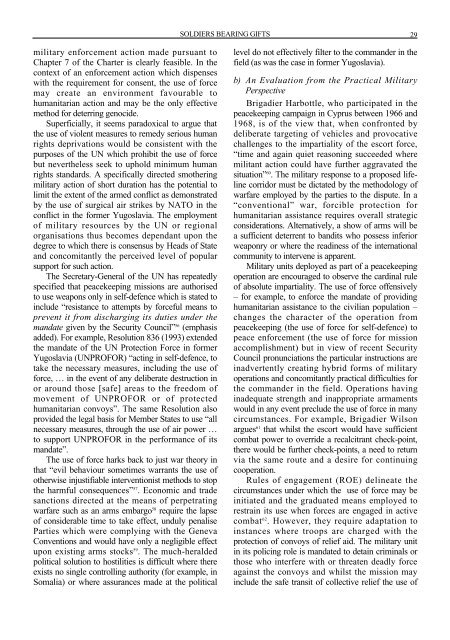ISSUE 125 : Jul/Aug - 1997 - Australian Defence Force Journal
ISSUE 125 : Jul/Aug - 1997 - Australian Defence Force Journal
ISSUE 125 : Jul/Aug - 1997 - Australian Defence Force Journal
Create successful ePaper yourself
Turn your PDF publications into a flip-book with our unique Google optimized e-Paper software.
SOLDIERS BEARING GIFTS29military enforcement action made pursuant toChapter 7 of the Charter is clearly feasible. In thecontext of an enforcement action which dispenseswith the requirement for consent, the use of forcemay create an environment favourable tohumanitarian action and may be the only effectivemethod for deterring genocide.Superficially, it seems paradoxical to argue thatthe use of violent measures to remedy serious humanrights deprivations would be consistent with thepurposes of the UN which prohibit the use of forcebut nevertheless seek to uphold minimum humanrights standards. A specifically directed smotheringmilitary action of short duration has the potential tolimit the extent of the armed conflict as demonstratedby the use of surgical air strikes by NATO in theconflict in the former Yugoslavia. The employmentof military resources by the UN or regionalorganisations thus becomes dependant upon thedegree to which there is consensus by Heads of Stateand concomitantly the perceived level of popularsupport for such action.The Secretary-General of the UN has repeatedlyspecified that peacekeeping missions are authorisedto use weapons only in self-defence which is stated toinclude “resistance to attempts by forceful means toprevent it from discharging its duties under themandate given by the Security Council” 56 (emphasisadded). For example, Resolution 836 (1993) extendedthe mandate of the UN Protection <strong>Force</strong> in formerYugoslavia (UNPROFOR) “acting in self-defence, totake the necessary measures, including the use offorce, … in the event of any deliberate destruction inor around those [safe] areas to the freedom ofmovement of UNPROFOR or of protectedhumanitarian convoys”. The same Resolution alsoprovided the legal basis for Member States to use “allnecessary measures, through the use of air power …to support UNPROFOR in the performance of itsmandate”.The use of force harks back to just war theory inthat “evil behaviour sometimes warrants the use ofotherwise injustifiable interventionist methods to stopthe harmful consequences” 57 . Economic and tradesanctions directed at the means of perpetratingwarfare such as an arms embargo 58 require the lapseof considerable time to take effect, unduly penaliseParties which were complying with the GenevaConventions and would have only a negligible effectupon existing arms stocks 59 . The much-heraldedpolitical solution to hostilities is difficult where thereexists no single controlling authority (for example, inSomalia) or where assurances made at the politicallevel do not effectively filter to the commander in thefield (as was the case in former Yugoslavia).b) An Evaluation from the Practical MilitaryPerspectiveBrigadier Harbottle, who participated in thepeacekeeping campaign in Cyprus between 1966 and1968, is of the view that, when confronted bydeliberate targeting of vehicles and provocativechallenges to the impartiality of the escort force,“time and again quiet reasoning succeeded wheremilitant action could have further aggravated thesituation” 60 . The military response to a proposed lifelinecorridor must be dictated by the methodology ofwarfare employed by the parties to the dispute. In a“conventional” war, forcible protection forhumanitarian assistance requires overall strategicconsiderations. Alternatively, a show of arms will bea sufficient deterrent to bandits who possess inferiorweaponry or where the readiness of the internationalcommunity to intervene is apparent.Military units deployed as part of a peacekeepingoperation are encouraged to observe the cardinal ruleof absolute impartiality. The use of force offensively– for example, to enforce the mandate of providinghumanitarian assistance to the civilian population –changes the character of the operation frompeacekeeping (the use of force for self-defence) topeace enforcement (the use of force for missionaccomplishment) but in view of recent SecurityCouncil pronunciations the particular instructions areinadvertently creating hybrid forms of militaryoperations and concomitantly practical difficulties forthe commander in the field. Operations havinginadequate strength and inappropriate armamentswould in any event preclude the use of force in manycircumstances. For example, Brigadier Wilsonargues 61 that whilst the escort would have sufficientcombat power to override a recalcitrant check-point,there would be further check-points, a need to returnvia the same route and a desire for continuingcooperation.Rules of engagement (ROE) delineate thecircumstances under which the use of force may beinitiated and the graduated means employed torestrain its use when forces are engaged in activecombat 62 . However, they require adaptation toinstances where troops are charged with theprotection of convoys of relief aid. The military unitin its policing role is mandated to detain criminals orthose who interfere with or threaten deadly forceagainst the convoys and whilst the mission mayinclude the safe transit of collective relief the use of
















